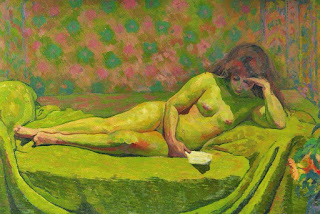"The
Wood of the Suicides" is one of the two stories by me that were nominated
for a Pushcart Prize. Every year, a book of award-winning stories and poems is
published—a very thick volume—and constitutes what is considered the best
writing of the year in English.
Nominations are supplied by magazines and journals, and even to be
nominated for one is considered an honor. I've been nominated three times (one
poem, two stories), though none of the nominations has landed my writing in the
Pushcart volume. Maybe someday . . .
The
story under discussion here originally appeared in a journal called Four-Cornered Universe, which folded after about a year. I let the
story sit but 1) since I don't write a lot of science fiction; and 2) since I thought
the story was a good one and wanted people to read it, I decided to work on it
and resubmit the piece.
"The
Wood of the Suicides" was inspired by Dante's Inferno. When Dante and Virgil visit the area of hell where the
violent are tormented for their sins, they come to a place of punishment for
suicides, those who are violent against themselves. The suicides are turned
into trees. The trees resemble humans somewhat; you can see faces on them and
you can identify them as male and female. They can talk to you. The deeper
their roots go down, the more their pain; and harpies, mythical creatures who
are half-human and half-bird, perch in their branches and tear at them, pulling
off the bark and drawing blood (reminiscent of a section of Virgil's Aeneid). I had read Inferno in an issue that carried French illustrator Gustave Dore's
woodcuts, and the one of the Wood of the Suicides stuck in my mind as
particularly gruesome.
But
my story was not about hell. I thought, What
if such a punishment was used not to torment but to rehabilitate? What if the purpose
of doing so was both benevolent and retributive?
"The
Wood of the Suicides" is told from the point of view of a Terran soldiers
stationed on a remote but strategic planet at the edge of Terran space. The
planet is inhabited by a race of beings called the Anva. They are a quiet,
unassuming people. Their skills in such areas as medicine and agriculture are
more advanced than any other race of beings in the galaxy. And they have a
unique way of dealing with murderers.
Cullen,
the main character, has a sister, Bria, also a soldier, who has murdered someone. The Anva turn
her into a tree, their standard sentence for murderers. Upon returning from a
deployment, Cullen's wife tells him the Anva have informed them that Bria's
term of "rooting" (imprisonment in the form of tree) has ended and
she is to be released. They set a time for him to pick her up. When he and his
wife arrive, they are surprised at a couple of things:
After a short while, two
priestesses came in with Bria. Two things startled him [Cullen] so much he
stood up.
One, she was naked.
But even more than that, she
was green.
He gaped. It embarrassed him
to see his sister bare. He had thought the change of clothing would be for
after she took off prison clothes. Instead, she had no clothing at all. And
what also amazed him was her apparent lack of concern about it. She did not
attempt to cover herself. Her eyes
looked bright, her face intelligent (if a little solemn); she did not seem
drugged or incapacitated in any way. She stood there with her arms to her side
as if being nude were the most natural and logical thing in the world and
nothing to wonder at.
Cullen
and Kassa, his wife, dress Bria and take her home. She asks him if it's
"okay" that she's green and says her color will never revert to what
it was before. The next day she tells about what it was like to be a tree. In a
sense, it was beautiful living an elemental life, feeling the rain, snow, cold
and heat. But being a tree was simple. Only one life system functioned. As a
human being, you had eight or nine systems working simultaneously. Bria has
learned, from the transitions her journey has taken her through, how complex
and miraculous a human being is—and has taught her the crime of destroying
another human life in all its glorious complexity. Her green coloration will
never go away. It will always remind her of what she has done. This is the Anva
way of dealing with murderers.
"The
Wood of the Suicides" turned out to be an adventure in the imagination. It
depended on an existing literary source but took the idea in new directions—which
is a primary mode of creative endeavor, at least as I see it. And this one got
an award!
Read "The Wood of the Suicides" in Empty Oaks. Scroll down to page 32.
For more titles, see my Writer's Page.
A great Halloween read is Le Cafe de la Mort. Coffee to Die For, Lady Death from Sandman
to serve you--along with Joe Black, Misa Amane,
Lady Death from "Appointment in Samara," and a mysterious Israeli woman who may be the Angel of Death from the book of Exodus.
I would love to hear your comments.


















